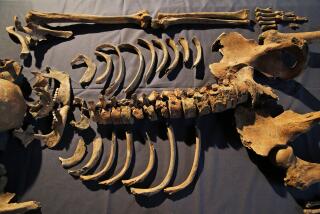Malaria parasite may have come from gorillas, scientists say
- Share via
One of the nastiest of the parasites that cause malaria may have originated in gorillas, scientists say after analyzing thousands of samples of primate feces. The findings may clear chimpanzees of much of the blame.
Previous studies had suggested that the malaria parasite Plasmodium falciparum, which infects humans, had evolved from a parasite that infected the common ancestor of humans and chimps before their lineages diverged 5 million to 7 million years ago. Another theory posited that humans had contracted the parasite from chimpanzees — as happened with HIV — possibly after hunting the primates for their meat.
To test these theories, researchers at the University of Alabama at Birmingham analyzed genetic material in samples of feces from many different types of primate species: chimpanzees, bonobos, western gorillas and eastern gorillas. Their findings were published online Wednesday in the journal Nature.
Extracting genetic information from gorillas in the wild is not an easy proposition, said Beatrice Hahn, a microbiologist at the university, who co-wrote the study. (Try drawing blood from a wild adult male gorilla.)
But after studies came out showing that genetic information could be extracted from animal droppings, Hahn and her colleagues realized they were in luck: They had close to 3,000 fecal samples in storage from earlier work on the simian immunodeficiency virus, the precursor to HIV in humans.
“They were just sitting there in our freezers, waiting,” Hahn said.
The researchers detected DNA from several types of Plasmodium parasite in the chimpanzee and western gorilla samples, but no trace of the malaria-carrying bug in bonobo or eastern gorilla waste.
And the gorilla samples contained a parasite nearly identical to Plasmodium falciparum, the most common and severe of human malaria parasites. Therefore, gorillas, not chimps, must have passed on the disease, Hahn said.
Knowing where malaria came from would bring researchers closer to understanding which diseases can jump between species, why they jump and, perhaps, whether such events might be prevented, Hahn added.
In an accompanying commentary in Nature, Penn State biology professor Edward Holmes called the results “striking,” though he added that the effort didn’t help scientists know when the parasite jumped from nonhuman primates to people.
Hahn estimated that such a one-time event might have occurred 5,000 to 300,000 years ago.
Austin Hughes, an expert on molecular evolution at the University of South Carolina in Columbia, said he was skeptical of the authors’ conclusions. He said there could be a lot more genetic diversity in the parasites infecting humans in Africa than scientists know of, and thus it was too early to say where Plasmodium falciparum originated.
Hughes added that he was worried that pinpointing gorillas (or chimpanzees, or bonobos, or any other primate) as the source of malaria would not endear the animals to local people, some of whom kill them for meat.
“There really are serious conservation issues,” he said.







